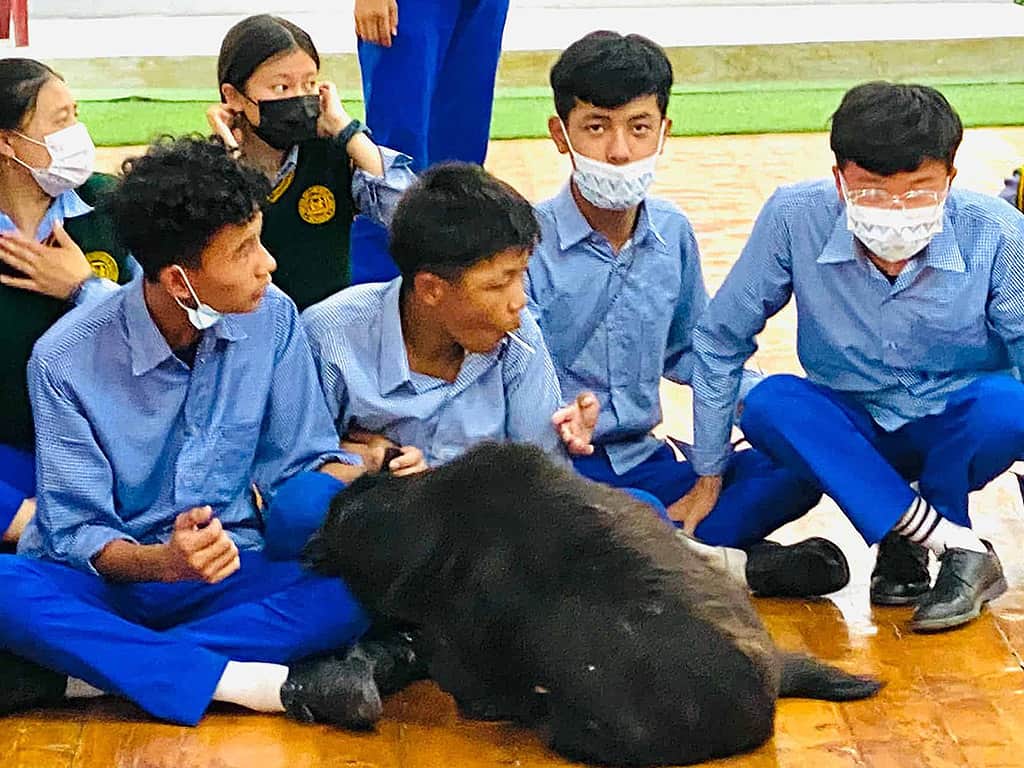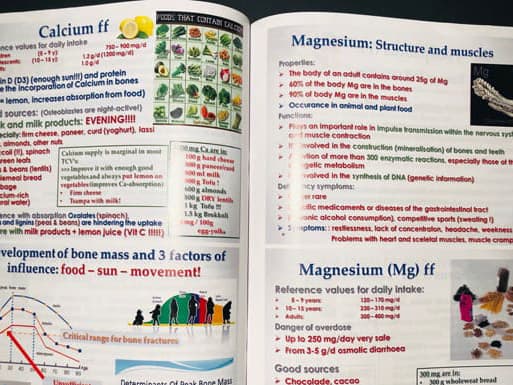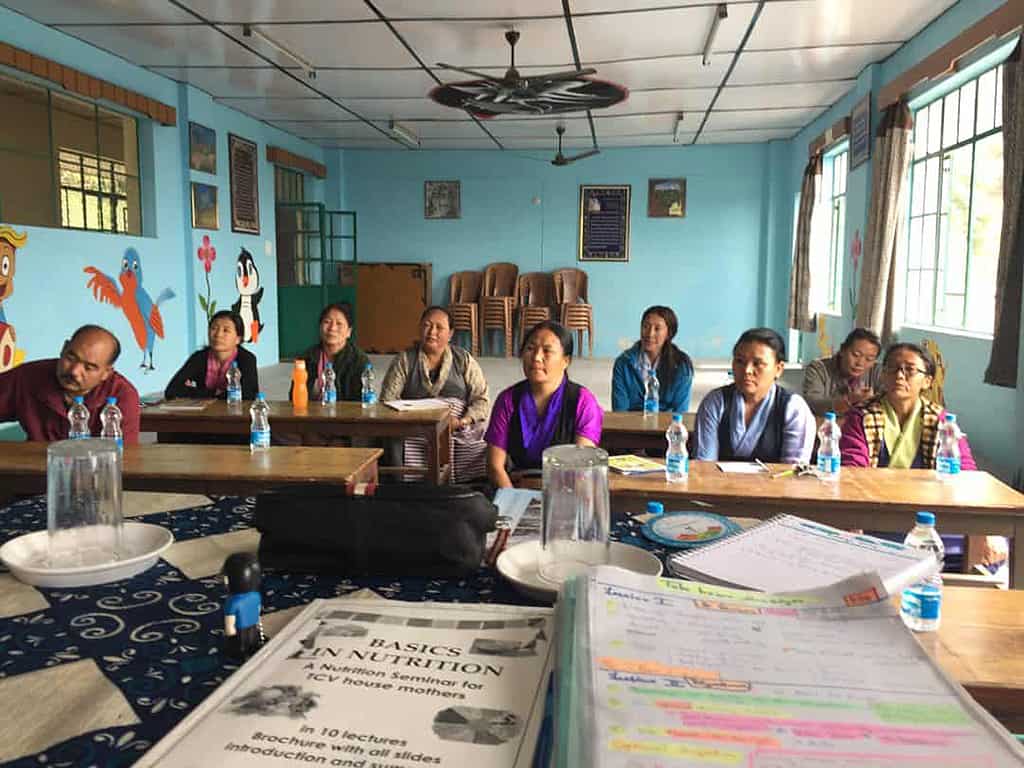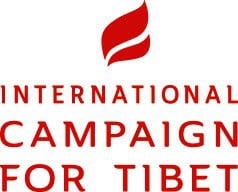Latest information from the TCVs and pictures: The year 2022
In April 2022 I was able to go back to Dharamsala for the FIRST TIME after the Corona years 2020 and 2021! What an event! And – In the luggage I had the new Tibetan Food Pyramid, not only in the 3 languages English, Tibetan (and German), but also with the additional brochure in the 3 languages!
Since we did not know during the planning of my trip whether we could already resume the nutritional trainings of the pre-Corona years and, moreover, the planning of the trip was very short term because of the Corona uncertainty, we had decided that we would dedicate the year 2022 entirely to the Tibetan Food Pyramid.
Various lectures on the Tibetan Food Pyramid followed in and near Dharamsala, all of which met with great enthusiasm:
– LHA (Social Work in Dharamsala)
– TDH (Tibetan Delek Hospital = Tibet. Hospital in Dharamsala)
– CTA (Central Tibetan Administration = Tibetan government in exile in India):
>>> Dpt. of Health (Ministry of Health)
>>> Dpt. of Education (Ministry of Education)
finally the new
– STSS (Sambhota Tibetan School Society = new authority, which is responsible for all Tibetan schools in India)
Everyone was enthusiastic and we delivered large posters of the food pyramid that we had printed at TCV Chautra. Finally, it was decided to print 10,000 of the additional brochures in English & Tibetan in a booklet: EVERY student of the 9th or higher grade should receive such a booklet in the future.
Finally, there was an opportunity to present the Tibetan Food Pyramid to all 8 school principals, who were also enthusiastic.
I was allowed to present the pyramid to the 9th, 10th and 12th classes of the *Upper TCV” in the headquarters of Dharamsala already in a 1-hour session and discuss it with them.
It was a very successful trip to publicize the Tibetan Food Pyramid and at the end, the training for 2023 was discussed and decided:
>>> We will continue where we left off in 2020, namely with the 2nd pass through TCV Selakui, TCV Bylakuppe in South India, TCV Choglamsar in Ladakh and of course – as always – the visit to our Snowland Farm in TCV Chauntra in North India.
The 2022 picture section, marked by lectures and information on the Tibetan Food Pyramid.


Backpack and Snowland Bag…

















































More details on feeding the approximately 7,500 kids in the 8 Tibetan Children’s Villages (TCV’s) in India.
In the afternoon, they clean up, do their homework, and as soon as they have a short break, they go to the garden or prepare dinner. So it’s easy to understand that they don’t have much time to study the books on nutrition training intensively….. In the years of the training weeks I could then never understand how they could organize it to come for a whole week (5 days) 2 times 3 hours to the lessons!
The older teenagers (10th – 12th grade, depending on TCV), i.e. the 14 – 18 year old kids, then move out of the small shared apartment and live together in larger groups in so-called “hostels”. However, they have smaller rooms (2 – 6) with more space for their own things and needs. They eat in the big communal dining room, and most of the time the food comes from the big kitchen, which also cooks for the staff at lunchtime.
In 2016, I gave nutrition lectures for 4 weeks at TDH (Tibetan Delek Hospital), the only Tibetan hospital outside of Tibet, in Dharamsala, for doctors and nursing staff. The director of the maternity training center at that time, Mrs. Kalsung Sharling, asked me to talk to her. She brought up her request to do a nutritional analysis based on various weekly and daily menu plans. It came out that the children are in any case calorically sufficiently nourished, i.e. receive enough food energy.
In detail, the nutritional analysis showed that the children are, on the whole, even more well-balanced than our children: they get significantly less but enough fat, have more than enough dietary fiber (which is usually much too little for us) and are fed a vegetarian diet. This is not because the Tibetans as a whole are vegetarians. They are Buddhists, but traditionally, due to the altitude (5,000 – 7,000 meters) and poor vegetation in Tibet, they fed themselves with sufficient (yak) meat. Therefore, even today in the lower climatic zones, they generally eat meat. In addition, the individual houses of the children’s villages do NOT have refrigerators until today (2021). Since it can get up to 45°C hot in summer, depending on the location of the respective children’s village, it is certainly better not to use meat. In addition, they are also cost-wise not able to offer meat to the children. Most of the time, the Amala has a very small refrigerator for itself, but it is not enough for the children.
If we go into the details of the analysis, we find that these young people of growing age get only 50% of their daily calcium requirement, girls of puberty age get too little iron, all a little too little of some B vitamins and probably also A vitamins and/or beta-carotene. Here it is not due to a lack of vegetables or salad (“salad” there is raw sliced onions, carrots or cucumbers, completely unseasoned), but rather due to the amounts and sometimes variety in vegetables. Many housemothers try very hard to grow vegetables in addition to their many jobs, but it depends on the area they have available and, of course, the time available.
And – the protein quality is quite good with the mostly Indian food (Indians as vegetarians know how to get enough protein by eating enough pulses like lentils, peas, etc. in combination with rice = so called Dal Bhat, and how to combine them favorably), but the quantity is just at the minimum. And – the protein intake is of course dependent on how many lentils are in the “dal”. If it is more of a soup, the protein content is also low. Therefore, in the course of my trainings, I got used to recite like a “Tibetan prayer wheel” “if I have to look for the lentils with a magnifying glass, there is never enough protein in it”.
In addition, the children usually get no or only very little milk (costs!) and also not every day an egg, but a maximum of 3-4 eggs per week. However, both would be essential in the present diet to ensure the protein supply (milk and eggs), calcium supply (milk!) and B vitamins and iron (eggs).
Here you can still find the full report 2017 – 2019 and many pictures from the 3 years of training so far!
Nutrition trainings in TCVs since 2017
Accompanying images to the text about nutrition trainings in TCVs
In the spring of 2019, we decided to create a “Tibetan Food Pyramid” . Why? In my opinion, the Indian Pyramid, which of course also exists, is unsuitable for a variety of reasons. For example, white rice, which is eaten 2-3 times a day in India, is placed at the top with “sweets, soft drinks and chips & co”. Of course it would be better to eat whole grain rice, but it is simply unrealistic to place whole grain rice in the “brown level” and banish white rice to the top. Then no one will take the pyramid seriously. Also, extra calcium tablets are recommended (rightly so) if you don’t take enough milk and dairy products. But – again – that is totally unrealistic to recommend for TCVs. The Swiss Pyramid, on the other hand, recommends milk and dairy products 5 times a day. Again – see above – this is not realistic for the TCVs (and these amounts are also unnecessary). In addition, the Swiss Pyramid has fruits and vegetables as the second lowest (= second most consumed food). This is not only unrealistic, but also outdated. So we decided to create a special pyramid for Tibetans, which hopefully will be used outside the Tibetan Children’s Villages.
After no trainings could take place in the Corona year 2020, we used the time to design this pyramid. “We” in this case are myself and the Science Council of TCV Chauntra, which also includes the former director of maternal counseling training, Mrs. Karlung Sharling. She has a degree from USA in nutrition counseling and of course was very helpful, as well as the other science members of the AG.
By the end of 2020, we completed the Pyramid, translated it into Tibetan and German, and printed it in the spring of 2021 (see there)
Another problem we had discovered in the meantime is that SNACKING: All TCVs have small stalls or kiosks where children can buy something with their scarce pocket money. And – as with most kids in the world, but also because of the low cost – Chips (10 ruppees of the 30 g bag) and Soft Drinks (they otherwise only get water or tea) are extremely popular. So if I add to the daily nutrition calculation 2 bags of chips (this is absolutely not unrealistic as I have seen many times) and 1-2 bottles of soft drinks, it’s over with the “balanced” nutrition: The (bad) fat shoots up and quickly exceeds the 30% energy share and the (empty) sugar calories make the already too high carbohydrate share with bad carbs (because sugar is too quickly available) shoot up even more. The protein portion of the daily diet then goes down even more.
So next we are also planning Posters for Snacking.
So overall there is still so much to do. There are already initiatives from other Europeans, especially one from Hamburg, who are making an effort to offer fruit and fresh fruit juices at the same price as chips, soft drinks and other sweets in the stalls. That is already a good approach. We have deliberately not chosen to ban the chips, soft drinks and other sweets, because it would not lead the children to give them up voluntarily. They would have relatives and friends bring it to them and “hit” it all the more as soon as they have the opportunity. We rely on self-determination and our own knowledge. The future will show whether we are right.
All these measures require additional financial resources. Based on the 2018 cost analysis, there is less than 50 centimes available per child per day (0.44 CHF). Besides the very great support from ICT (International Campaign for Tibet) Germany, we are still looking for other organizations, to help us in our efforts.
If we want to give the 8,000 children a glass of fresh milk and 1 egg extra per day, we need 750,000 CHF/year based on NUMBEO (cost of living in India, February 2020). Here we are urgently looking for support from other organizations or even SDC, Swiss Development Aid.
The training materials, in the 3rd edition finally in color!





The training of the housemothers is successful and enjoyable
At the end we always take a group picture, in between we visit some houses to see the normal life of the children. There is always a lot going on, the children romp around the sports field, but also help their housemothers with their daily chores.



Since 2019, there has also been a week of block teaching in ITI (Selakui, North India) and with the older students in grades 10 – 12.
In the ITI (apprenticeship training), the apprentices come mainly from the areas of “Food Production” (cooks), “Food and Beverages” (service) and “Bakery” (bakers). There are 70 – 75 young girls and boys between the ages of 18 and 25 who attend the nutrition course. The interest is enormous and the breaks generally pass with lively discussions and questions.






Some impressions of the trainings of 2017 and 2018 in the different Tibetan Children’s Villages
















